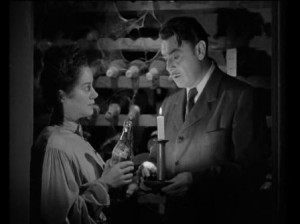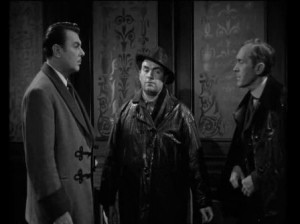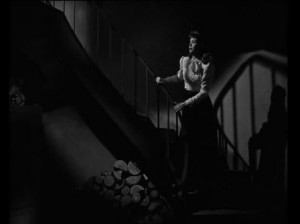 In one of the film’s best and eeriest scenes, Albert and Mrs. Oates descend the staircase to fetch a bottle of brandy, since the ether used as a stimulant for Mrs. Warren has oddly disappeared. The maid blows out the candle and tosses it away, and while she misdirects the professor to look in a dark corner—“I think it rolled under there, sir.”—she lifts a bottle from its rack and slips it under her apron.
In one of the film’s best and eeriest scenes, Albert and Mrs. Oates descend the staircase to fetch a bottle of brandy, since the ether used as a stimulant for Mrs. Warren has oddly disappeared. The maid blows out the candle and tosses it away, and while she misdirects the professor to look in a dark corner—“I think it rolled under there, sir.”—she lifts a bottle from its rack and slips it under her apron.
Despite the noir shadows and cryptic score—both atmospherically expectant—nothing untoward happens. This candle trick, which Mrs. Oates later brags to Helen as one on the professor, will inspire the young girl herself when she is alone in the basement with Steven and is able to lock him in a storeroom.
In another terrifying scene, in the climax, when Helen is finally pursued by the killer—as was bound to happen—for she, too, has an impairment, she beats on an upstairs window to get the attention of the constable, who is about to leave in his horse and buggy. He hears the sound, even stepping down from his seat. Thinking it’s only the banging of a shutter or the rain—it is, of course, raining—he drives away.
And just who is the killer, this person who announces, “There’s no room in the whole world for imperfection”? There are numerous suggestions, clues and omens. The window that is found open, the rain splashing in: “I closed that window when the storm started,” Mrs. Oates mutters. The arrival of the raincoated Mr. Oates soon after Helen enters from the storm: “Anything wrong, Albert?” The arguments between Albert and Steven: “I don’t like you,” says the professor. “I never have.”
One scene in particular narrows down the field, so to speak. While Helen is admiring herself in a full-length mirror, perhaps imagining how it would be to have a voice and see her lips move with matching words, the camera pulls up the staircase and moves along an upper landing, revealing the trousered legs of someone—and then the ever-watchful eye and, yes, the theremin. Mirrors, like staircases and thunderstorms, are a motif in the film; there are three alone in Mrs. Warren’s bedroom, including one on the medicine cabinet door.
 Well, one thing is for sure, then: the murderer is in the house! And, yes, presumably a man. Now, if the viewer is keeping track of things—— Was Dr. Parry visiting at the time? Where was Mr. Oates? The constable is always dropping in, once to warn everyone that the murderer has been traced “to this vicinity.” Where in the house was Steven? And the professor? And so on.
Well, one thing is for sure, then: the murderer is in the house! And, yes, presumably a man. Now, if the viewer is keeping track of things—— Was Dr. Parry visiting at the time? Where was Mr. Oates? The constable is always dropping in, once to warn everyone that the murderer has been traced “to this vicinity.” Where in the house was Steven? And the professor? And so on.
Mrs. Warren has been warning Helen to leave the house, even begging Dr. Parry to take her with him when he goes to town. She asks Steven, who has just recently returned from Europe, “Why did you have to come back? . . . There’s always trouble when you come, Steven.” Does she know something, or does she just, well, suspect something, or is her pointing finger a deliberate red herring?
Dorothy McGuire is a totally sympathetic heroine, and she is perhaps the one person who is above suspicion. Even Mrs. Warren, confined to her bed, can be ruled out. Or should she be? Yes, it’s ridiculous to consider her—ridiculous, though as many times as not characters in beds and wheelchairs end up being the ones who do the doing in, even someone without legs, as in Night Monster—figure that one out!
It’s true that Albert lacks personality (as usual, a sedate performance by Brent), Steven is thoroughly unlikable (it’s obvious why Blanche avoids him) and Dr. Parry is tepid as a romantic (sincere, it seems, to the core). The maid is the possible culprit, though “not the type.” Blanche, for one, can be eliminated from the list of suspects, for that best reason of all.
 Besides The Spiral Staircase, cinematographer Nicholas Musuraca and composer Webb brilliantly combined their talents in a number of high-class, though low-budget horror films of the ’40s: Cat People, Bedlam, Curse of the Cat People and The Ghost Ship, all produced by Val Lewton. Webb also scored The Body Snatchers (1945), Notorious, one of my top-ten favorite films, and Top Secret Affair, a guilty pleasure, Mickey-Mousing and all.
Besides The Spiral Staircase, cinematographer Nicholas Musuraca and composer Webb brilliantly combined their talents in a number of high-class, though low-budget horror films of the ’40s: Cat People, Bedlam, Curse of the Cat People and The Ghost Ship, all produced by Val Lewton. Webb also scored The Body Snatchers (1945), Notorious, one of my top-ten favorite films, and Top Secret Affair, a guilty pleasure, Mickey-Mousing and all.
It’s often assumed that second-string film composers, less well-knowns like Frank Skinner, Laurence Rosenthal, Les Baxter, the impressively named Daniele Amfitheatrof, Anthony Hopkins and so many others, have no stylistic personality. Granted, some don’t. Even those just listed haven’t the strong musical fingerprints of a Korngold, a Herrmann or a Rózsa, perhaps the “biggies” with the most identifiable sound.
But some of those obscure composers—clearly Roy Webb—have a recognizable style, to some degree and with the right esthetic challenges. If for output alone—he scored more than 250 films between 1930 and 1958—Webb should be regarded, which he isn’t, as a major film composer. As proof that he has a degree of style, personality, whatever it’s called, there is Helen’s first scene with Mrs. Warren when moments in the score recall Webb’s work in Notorious. Self-plagiarism maybe. Maybe something else: the spark of originality.
One thought to “The Spiral Staircase (1946)”